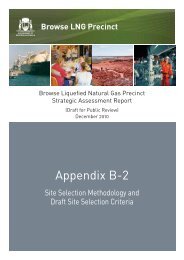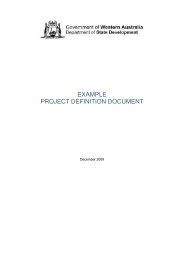Browse LNG Precinct - Public Information Booklet - Department of ...
Browse LNG Precinct - Public Information Booklet - Department of ...
Browse LNG Precinct - Public Information Booklet - Department of ...
You also want an ePaper? Increase the reach of your titles
YUMPU automatically turns print PDFs into web optimized ePapers that Google loves.
<strong>Public</strong> <strong>Information</strong> <strong>Booklet</strong><br />
Flares<br />
Questions:<br />
� Will there be a flare?<br />
� Where is the flare going to be?<br />
� How many flares are required?<br />
� How high will it be?<br />
There are 3 flares required for the potential Woodside foundation development (up to 3<br />
trains at first) these include:<br />
� An emergency flare, this will be a tall flare structure (approximately 150 metres or 500<br />
feet high) which has three flare outlets (one outlet for very cold gas, one outlet for<br />
warm gas, and a spare which is normally disconnected). This flare will very rarely be<br />
operated and typically will only be for short amounts <strong>of</strong> time.<br />
� A marine flare for the <strong>LNG</strong> tanks and loading system which is only used occasionally<br />
(approximately 50 metres or 160 feet high); and<br />
� An operational flare, which is low, and likely to be flaring small amounts <strong>of</strong> gas on a<br />
regular basis (approximately 30 metres or 100 feet high).<br />
As the purpose <strong>of</strong> an <strong>LNG</strong> plant is to make as much <strong>LNG</strong> as possible, the idea is to<br />
minimise the amount <strong>of</strong> flaring (or gas that is burnt <strong>of</strong>f) to maximise the amount <strong>of</strong> <strong>LNG</strong><br />
sold. As a result, flaring is minimised with only the smaller operational flare be regularly<br />
used.<br />
Question - Can there be a ground flare instead <strong>of</strong> flare tower?<br />
The option <strong>of</strong> a ground flare is being looked at for the operational flare, but not for the<br />
emergency flare. This is because repair and maintenance <strong>of</strong> the emergency flare must<br />
be possible while the plant is operating. A ground flare can not be fully accessed when<br />
the plant is operating, and would require all gas, liquids and pressure to be removed from<br />
the entire plant, which would cause unacceptably long plant shutdowns. In addition a<br />
ground flare takes more land area than a flare tower and is noisier.<br />
Darwin <strong>LNG</strong> is able to use a ground flare as it only has a single train and any required<br />
flare maintenance can coincide with a shutdown <strong>of</strong> the single <strong>LNG</strong> train. For multiple<br />
<strong>LNG</strong> trains maintenance is staggered to minimise the temporary maintenance workforce<br />
which results in the flare always needing to be available.<br />
Woodside is continuing to look at where a ground flare may be possible to be used.<br />
Questions:<br />
� What light and heat comes from the flares?<br />
� How bright will it be?<br />
5279225 53









